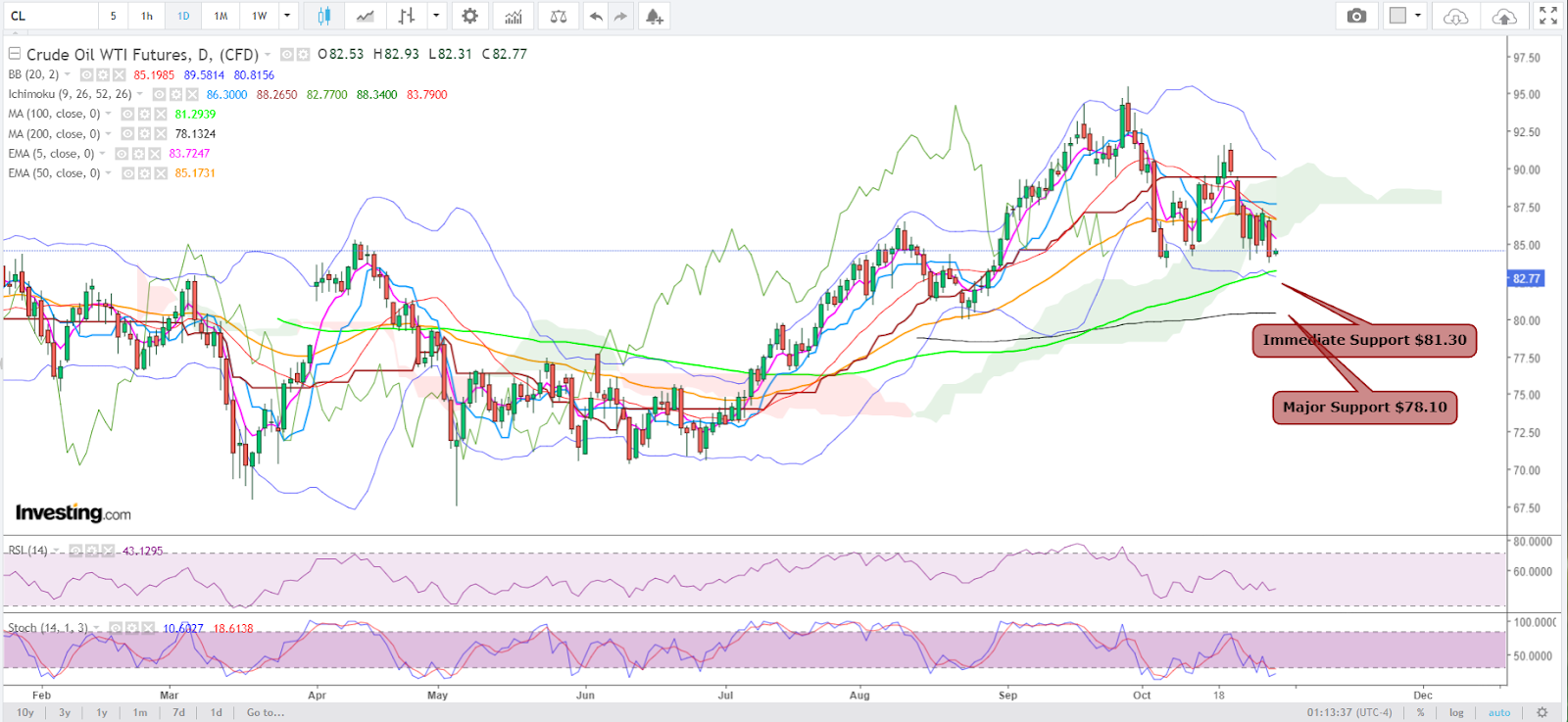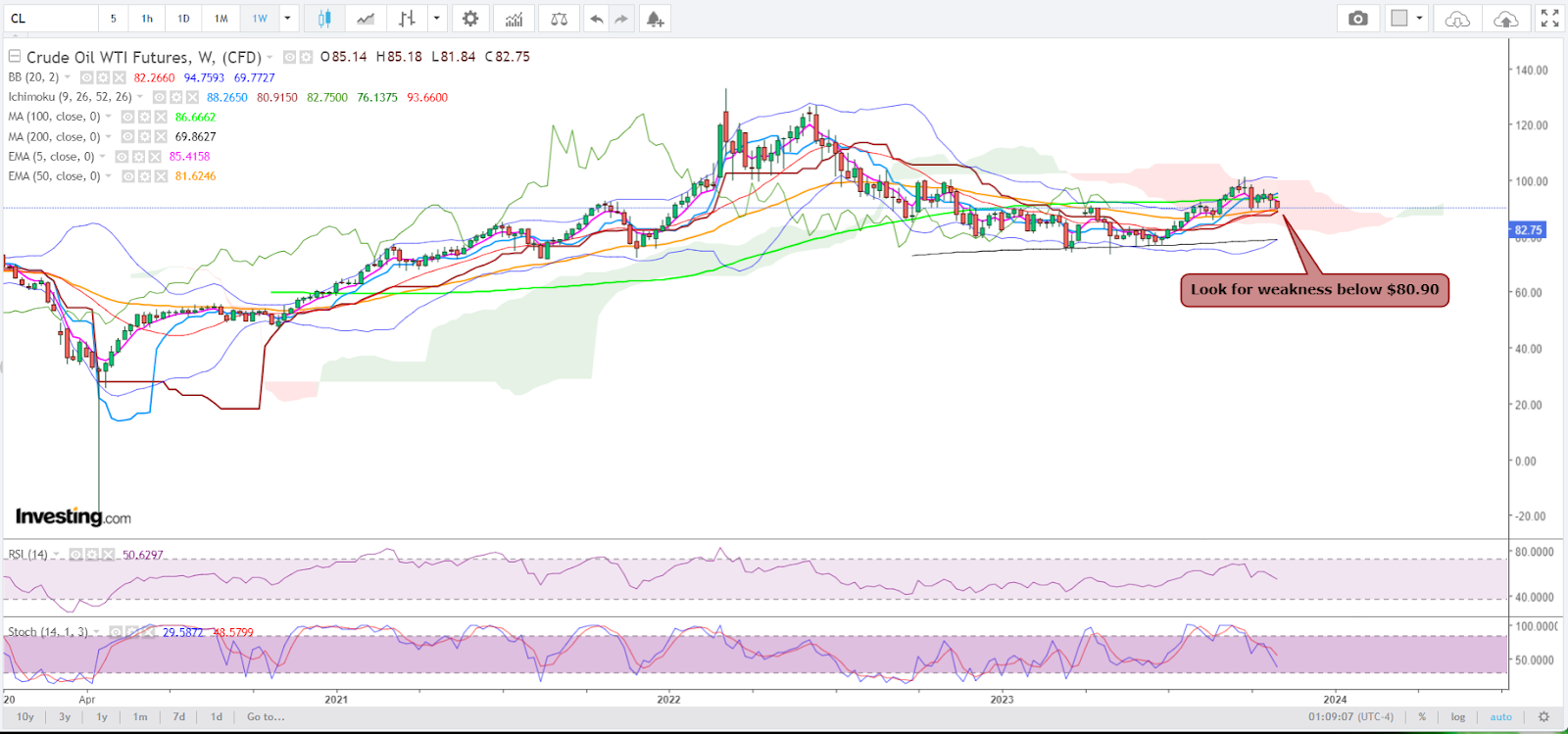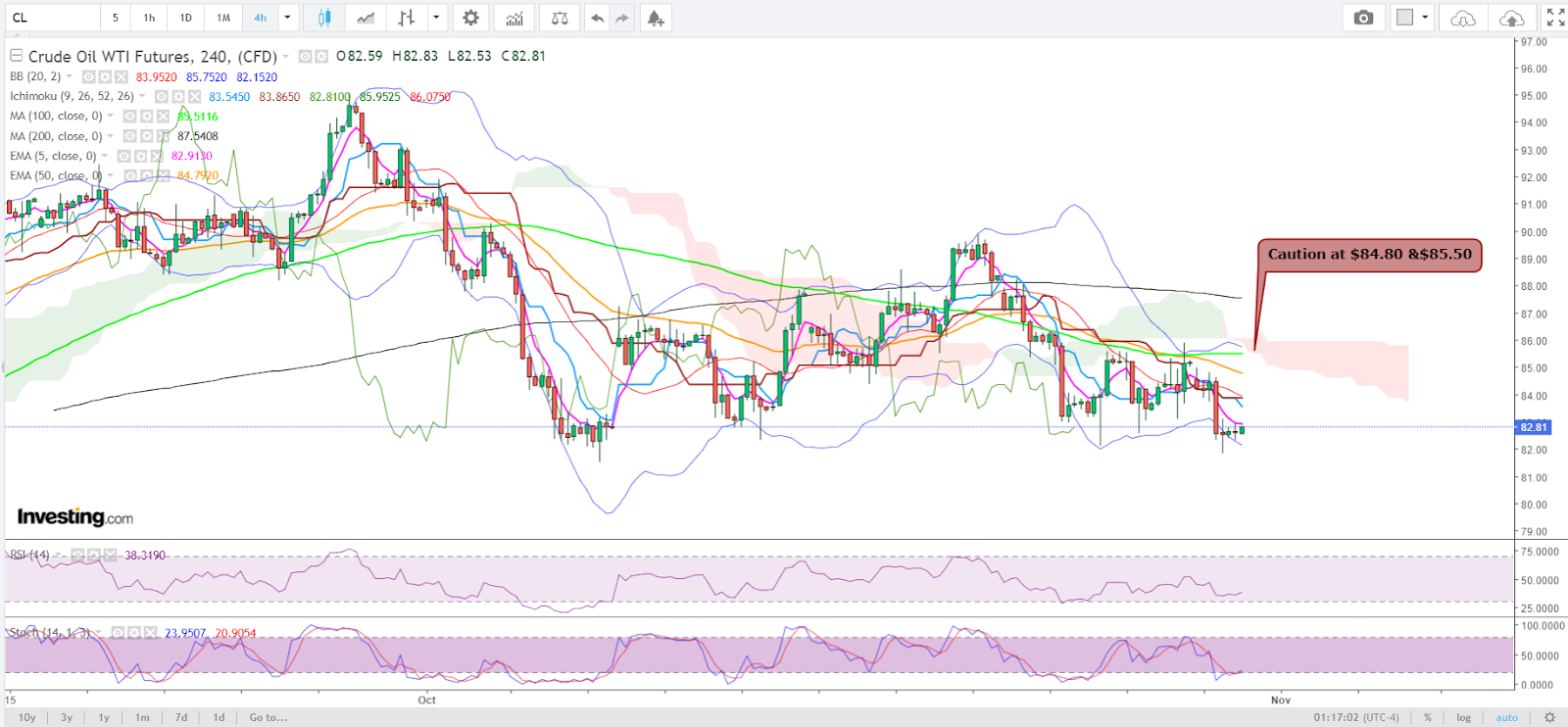- More than three weeks into Israel-Hamas war, crude prices are barely any higher than where they were before start of conflict
- In fact, Russia-Ukraine war and similar declining impact on oil prices was a lesson not learned by oil bulls
- WTI could break below $80 a barrel, though a rebound also possible, given volatility
Real impact, not just proximity: That’s the takeaway for oil bulls who expected the Israel-Hamas war to guarantee pricing at $100 per barrel or more, only to realize that even the worst fighting the Middle East has seen in decades cannot give them a free ride unless the crude traffic itself takes a hit.
More than three weeks into the conflict that has killed nearly 10,000 people and shocked the world almost daily with one headline of escalation after another, crude prices are barely any higher than where they were before the start of the whole thing.
The whole thing has a ring of familiarity to it; a sort of a deja vu. Oil bulls also went on the overdrive after Russia’s invasion of Ukraine in February 2022, sending prices to above $139 for global benchmark Brent and above $130 for US crude’s West Texas Intermediate, or WTI. All charts by SKCharting.com, with data powered by Investing.com
All charts by SKCharting.com, with data powered by Investing.com
From there, prices began a descent that sharpened month after month, with WTI reaching below $64 by May this year and Brent falling to a little above $70 by March. At the height of the Ukraine war, there was real dysfunction to the global oil trade from sanctions on Russian oil and supply bottlenecks still in place after COVID-19 outbreak.
Despite that, the release of hundreds of millions of barrels of US emergency crude supplies calmed the market, eventually wiping out any war premium for oil.
Fast forward to now: OPEC+ — the 23-nation alliance of oil producers that combines the 13-member Saudi-led Organization of the Petroleum Exporting Countries with 10 independent producers led by Russia — is cutting 3.66 million barrels in daily supply.
Despite those cuts, concerns over demand destruction continue to pressure crude prices.
Oil Prices In Yo-Yo Mode
Crude longs thought the Israel-Hamas war would provide the prop to take oil back to triple-digit pricing. As the days pass, that proposition seems more challenging with crude prices standing not far from where they were before the fighting began.
Case in point: The front-month in US West Texas Intermediate, or WTI, crude settled at $82.79 per barrel on Oct. 6, one day prior to the Hamas attack in southern Israel that triggered the war.
At the time of writing, the front-month for the US crude benchmark was at $83.02, having settled at $82.31 in the previous session and struck a three-week low of $81.82. The best WTI did was $90.78 on Oct 20.
In fact, WTI has been in yo-yo mode for a week now, rising or falling more than 2% in a session, as traders scratched their heads on what sort of risk premium to attach to a war which has virtually had zero impact thus far on the global oil trade.
Brent, the crude of UK-origin, has done better, of course, going from an Oct 6 price of $84.58 to $93.79 on Oct 20. At the time of writing, Brent was at $86.92.
But while the global crude benchmark has performed better than WTI, but it still way below the three-digit bet of oil bulls.
Traders said It would be remiss to say the market wasn’t following the war in the Middle East that erupted on October 7 after Hamas gunmen paraglided into Israel and killed nearly 1,500 Israelis and took some 200 hostage.
War Premium? Really?
But there has also been no disruption to oil traffic in the Middle East — particularly with barrels moving in waters around the battle zone — and, as such, it is hard to maintain a war premium risk for crude just on grounds of proximity, those in the know said.
“What war premium?” Ed Moya, analyst at online trading platform OANDA, asked in his market note on Monday.
“Crude is lower as two wars have yet to disrupt crude flows. As Middle East crude supply concerns ease, demand destruction is happening and it could get a lot worse if the bond market selloff returns,” Moya said, referring to the concurrent run-up in bond yields that forced oil to plunge as hard as it rose on many occasions over the past three weeks as investors feared a global economic slowdown, or at least an European recession.
Added Moya:
“If global bond rates end much higher, (at what) will be consider(ed) uncomfortable levels, that will crush both the short-term growth prospects and the crude demand outlook.”
“As Middle East crude supply concerns ease, demand destruction is happening. This slide in oil prices means that geopolitical angst won't be enough to send prices higher. Too much demand destruction is happening and the oil market is losing its tightness despite all the risks to supply flows that remain on the table.”
Many who were long crude had expected the market to take off with the ground invasion of Gaza that Israel had held back for weeks as global powers tried to negotiate the block release of the 200 over Israeli hostages held by Hamas. But as a deadline that Prime Minister Benjamin Netanyahu set for himself expired on Friday, Jerusalem continued with its mission to flush Hamas once and for all from the Palestinian territory, ruling out any ceasefire.
CMC Markets analyst Tina Teng, commenting on this, said:
"Despite an escalation in the Hamas-Israel war, the ground invasion was widely expected. The weekend playout signals no further expansion into a wider regional war, which caused a retreat in oil prices."
Weekend playouts, as referenced by Teng, typically involves a dose of reality for oil bulls on Monday when trading usually gets to a sluggish start from sheer hype or premium from uncertainty built up on a Sunday.
John Evans of oil broker PVM said in comments explains this phenomenon.
"There is a propensity for market users in all their guises to have at least some oil length going into the weekends and when the fear of conflict spread shows no validation come the early hours of Monday mornings' openings, that fear hedge is ordinarily unwound,"
Good, Sound Reason for Oil Selloff?
And sometimes, there's good, sound economic reason for such unwinding, like this week.
Crude prices tumbled almost 4% on Monday as speculation over the Federal Reserve’s interest rate decision later in the week extended the flip-flop over the war risk premium that oil ought to assign to the fighting going in the Middle East.
Concerns over how US jobs numbers for October will turn out on Friday — and how that might impact the Fed’s next rate decision in December — also kept oil traders on the edge.
In the Federal Reserve’s case, while rates are expected to be kept unchanged at its Wednesday policy meeting for November, officials are mulling another rate hike before the end of the year. That could come at the Fed’s December rate decision, especially after several hotter-than-expected inflation readings.
Traders are also wary about the US non-farm payrolls report for October due on Friday. After a blockbuster 336,000 jobs were added in September, economists are expecting more moderate jobs growth of 182,000, which is still consistent with a robust labor market.
The unemployment rate is expected to remain at 3.8%, while wage growth is expected to ease to 4% year-on-year, which would mark a post-pandemic period low, and could help bolster the Fed’s view that price pressures are easing and that it doesn't need to raise interest rates any further, relieving pressure on economic activity in the largest oil consumer in the world.
Ahead of Friday’s data, market participants will be looking at data on third-quarter employment costs on Tuesday for signs that wage growth is moderating.
But before the Fed meeting, markets are also awaiting key purchasing managers index data from China, which is set to shed more light on business activity in the world’s biggest oil importer.
China’s economy has shown some signs of stabilizing in recent months after seeing a sharp decline in growth this year. The country’s aviation regulator recently said it will increase domestic flights to 34% above pre-pandemic levels- a positive sign for oil demand, although air travel still makes up a small portion of China’s overall fuel consumption.
The Bank of Japan is also set to meet on Tuesday, with traders pricing in a potential policy shift in the bank as it grapples with rising inflation.
WTI Outlook — A Break Below $80 Likely, Though Rebound Possible, Too, Given Volatility
 The US crude benchmark looks poised to go below $80 a barrel if its current rate of decline continues, though the potential for it to rebound to current from that break below is also fairly high — given the volatility in the market.
The US crude benchmark looks poised to go below $80 a barrel if its current rate of decline continues, though the potential for it to rebound to current from that break below is also fairly high — given the volatility in the market.
Says Sunil Kumar Dixit, chief technical strategist at SKCharting.com:
“Amidst the daily whipsaw price action, WTI shows a typical consolidation towards immediate support seen at the 100-day ascending SMA, or Simple Moving Average of $81.30, followed by the horizontal support of $80.90.
If this zone fails to hold as support, look for a drop to $79.35, below which the 200-day SMA, statically positioned at $78.10, would be eyed.”
Dixit said worthy of market attention, is that as long as geopolitical crises such as Gaza and Ukraine remain unresolved, supply chain concerns will continue to make oil a buy-the-dip than and sell-the-rally play.
“Meanwhile, WTI at $84.80 and $85.50 zone will continue to pose a challenge for any recovery attempts to establish a rebound and reclaim the $90 perch.”

***
Disclaimer: The aim of this article is purely to inform and does not in any way represent an inducement or recommendation to buy or sell any commodity or its related securities. The author Barani Krishnan does not hold a position in the commodities and securities he writes about. He typically uses a range of views outside his own to bring diversity to his analysis of any market. For neutrality, he sometimes presents contrarian views and market variables.
Which stock should you buy in your very next trade?
AI computing powers are changing the stock market. Investing.com's ProPicks AI includes 6 winning stock portfolios chosen by our advanced AI. In 2024 alone, ProPicks AI identified 2 stocks that surged over 150%, 4 additional stocks that leaped over 30%, and 3 more that climbed over 25%. Which stock will be the next to soar?
Unlock ProPicks AI